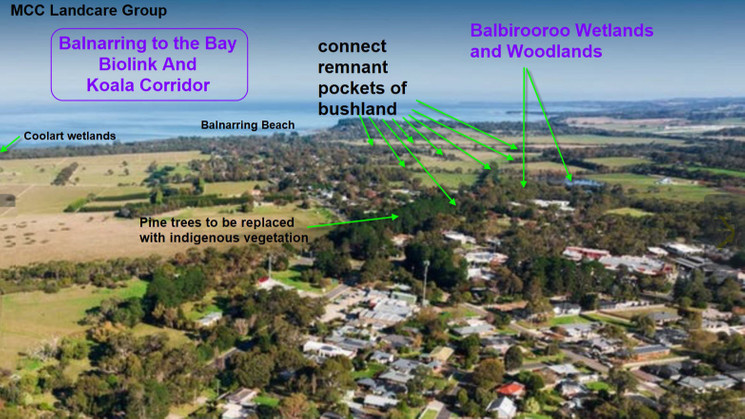A biolink from the centre of Balnarring to the mouth of Merricks Creek at Somers
The Balnarring to the Bay Biolink project will create a biolink along a natural drainage line from the centre of Balnarring to the mouth of Merricks Creek at Somers.
Through control of exotic species and revegetation, the biolink connects fragmented areas of remnant vegetation including the endangered swamp paperbark vegetation community, increasing habitat for native fauna and providing a safe corridor for the local koala population.
Linking Balbirooroo Wetlands to Merricks Creek across four private properties, the biolink continues on through Crown land and on to Western Port. The Balnarring to Bay biolink area forms nearly 44 hectares within the environmentally significant Western Port Biosphere.
The project supports significant work being undertaken by Melbourne Water to revitalise Merricks Creek.

Themes and Local Areas
| Primary Theme: | Native Vegetation |
| Other Themes: | Native Animals, Soil Health, Waterways, Wetlands, Coasts, Estuaries, Marine Environments, Communities, Climate Change |
| Primary Local Area: | Mornington Peninsula |
| Other Local Areas: | |
| Project location: | Civic Court Balnarring to Somers |
| Scale of the project: | Local |
| New or continuing work: | New project/work |
Project partners
| Lead organisation: | Merricks Coolart Catchment Landcare Group |
| Key partners: | Mornington Peninsula Landcare Network, Balnarring Pre-school, Balnarring Primary School, Mornington Peninsula Shire Council, Melbourne Water, Department of Energy, Environment and Climate Action (DEECA), Balnarring Foreshore Reserve Committee, Parks Victoria (including Friends of Coolart), Somers School Camp, Lord Somers Camp, private landholders and local businesses |
| Registered Aboriginal Party/s relevant to the project or its area: | Bunurong Land Council Aboriginal Corporation |
Investment opportunities
| Opportunities for investors within this project start from: | $$ (Tens of thousands of dollars) |
| Estimated scale of investment for full project implementation: | $$$ (Hundreds of thousands of dollars) |
| Estimated timeframe for full project implementation: | 2-10 years |
Contribution toward targets
| Primary Regional Catchment Strategy targets and contribution to its achievement: | Major new biolinks – Significant, sustained revegetation programs have been undertaken from 2021 to 2050 and have created numerous major biolinks in priority locations across the region Waterways – Vegetation extent along waterways, Vegetation quality along waterways, Native vegetation – Revegetation Native animals – Diversity of native animals, Threatened Animals (including White-throated Needletail, Common Long-necked Tortoise and Lewin’s Rail ) Communities (Community Volunteering, Community Participation) Climate Change (leading to significant contributions to carbon sequestration) |
| Relevant Biodiversity 2037 goal: | Revegetation of priority areas for connectivity between habitats |
| Relevant National Landcare Program priority: | Ramsar – Western Port Ramsar site – Ecological character maintained or improved |
More information
Merricks Coolart Catchment Landcare Group Email: mcclandcaregroup@gmail.com



